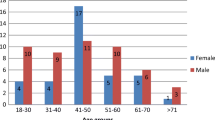Abstract
Human skull has always been used for victim identification in forensic odontology. The gender-dimorphic bone of the skull is the mandible. The gonial angle has frequently been investigated for gender estimation with variable results and requires further exploration. We aim to compare the efficacy of gonial angle estimation by ancient methods of lateral cephalometric tracing compared with more recent digital analysis methods for gender estimation in the Indian population. Lateral cephalograms of 191 (96 M and 95F) cases above the age of 17 years were retrieved. Cephalometric analysis of gonial angle on radiographs was done using both manual cephalometric tracing method and digitally using Adobe Photoshop software. The results were subjected to statistical analysis for evaluation. The mean gonial angle was higher in females (125.05; 123.77 and 125.28) than in males (122.583; 121.715 and 122.008) using both manual and digital methods. On applying the logistical regression analysis (LRA), the digital method showed the highest gender estimation accuracy of 60.7% followed by Burstone’s analysis (57.1%) and manual conventional analysis (56.5%). Burstone’s analysis (57.9%) correctly identified increased females, whereas digital analysis (62.5%) and manual conventional analysis (59.4%) accurately recognised increased males. The present study showed a higher gender estimation accuracy using digital methods as compared to manual methods, but it still lacks the credibility to be used as a sole factor for predicting the gender of an individual. Hence, a cumulative factor must be taken into consideration for gender identification which would provide more promising results.



Similar content being viewed by others
References
Vyas T. Forensic odontology: an overview. Int J Drug Res Dent Sci. 2020;2(2):1–2.
Dirkmaat DC, Cabo LL, Ousley SD, Symes SA. New perspectives in forensic anthropology. Am J Phys Anthropol Official Publ Am Assoc Phys Anthropol. 2008;137(S47):33–52.
Đurić M, Rakočević Z, Đonić D. The reliability of sex determination of skeletons from the forensic context in the Balkans. Forensic Sci Int. 2005;147(2–3):159–64.
Vinay G, Mangala Gowri SR, Anbalagan J. Sex determination of human mandible using metrical parameters. J Clin Diagnostic Res JCDR. 2013;7(12):2671.
Belaldavar C, Acharya AB, Angadi P. Sex estimation in Indians by digital analysis of the gonial angle on lateral cephalographs. J Forensic Odontostomatol. 2019;37(2):45.
Upadhyay RB, Upadhyay J, Agrawal P, Rao NN. Analysis of gonial angle in relation to age, gender, and dentition status by radiological and anthropometric methods. J Forensic Dent Sci. 2012;4(1):29.
Bathla S, Srivastava SK, Sharma RK, Chhabra S. Influence of age on the radiomorphometric indices of the gonial region of mandible in North-Indian population. Int J Med Dent Sci. 2014;3(2):411–20.
Sangvichien S, Boonkaew K, Chuncharunee A, Komoltri C, Piyawinitwong S, Wongsawut A, Namwongsa S. Sex determination in Thai skulls by using craniometry: multiple logistic regression analysis. Siriraj Med J. 2007;59(5):216–21.
Amin W, Othman D. Gender dimorphism of crania in young Jordanian adults: discriminant function analysis approach for gender prediction. J Curr Surg. 2014;4(3):76–85.
Khaitan T, Kabiraj A, Ginjupally U, Jain R. Cephalometric analysis for gender determination using maxillary sinus index: a novel dimension in personal identification. Int J Dent. 2017;8:2017.
Ramaswamy P, Khaitan T. Frontal sinus index–a new tool for sex determination. J Forensic Radiol Imaging. 2014;2(2):77–9.
Agarwal N, Bagga DK, Sharma P. A comparative study of cephalometric measurements with digital versus manual methods. J Indian Orthod Soc. 2011;45(3):84–90.
Albarakati SF, Kula KS, Ghoneima AA. The reliability and reproducibility of cephalometric measurements: a comparison of conventional and digital methods. Dentomaxillofac Radiol. 2012;41(1):11–7.
Ayoub F, Rizk A, Yehya M, Cassia A, Chartouni S, Atiyeh F, Majzoub Z. Sexual dimorphism of mandibular angle in a Lebanese sample. J Forensic Leg Med. 2009;16(3):121–4.
Radhakrishnan PD, Varma NK, Ajith VV. Dilemma of gonial angle measurement: panoramic radiograph or lateral cephalogram. Imaging Sci Dent. 2017;47(2):93–7.
Memon S. Comparison between three methods of gonial angle formation on lateral cephalogram and orthopantomogram. JPDA. 2018;27(02):58.
Abuhijleh E, Warreth A, Qawadi M, Abdulrida E, Radaideh A, Al Taki A, Mathew A, Varma S. Mandibular gonial angle measurement as a predictor of gender-a digital panoramic study. Open Dent J. 2019 Nov 28;13(1).
Mehta H, Bhuvaneshwari S, Singh MP, Nahar P, Mehta K, Sharma T. Gender determination using mandibular ramus and gonial angle on OPG. J Indian Acad Oral Med Radiol. 2020;32(2):154.
Alfawzan AA. Gonial angle as a determinant of gender, a panoramic study in a sample of Saudi population. Executive Editor. 2020;11(01):1689.
Apaydın B, Icoz D, Yasar F, Akgunlu F. Evaluation of mandibular anatomical formation for gender determination in Turkish population. Balkan J Dent Med. 2018;22(3):133–7.
Behl AB, Grewal S, Bajaj K, Baweja PS, Kaur G, Kataria P. Mandibular ramus and gonial angle—identification tool in age estimation and sex determination: a digital panoramic radiographic study in north Indian population. J Indian Acad Oral Med Radiol. 2020;32(1):31.
Author information
Authors and Affiliations
Corresponding author
Ethics declarations
Conflict of interest
The author declares no competing interests.
Additional information
Publisher's Note
Springer Nature remains neutral with regard to jurisdictional claims in published maps and institutional affiliations.
Rights and permissions
Springer Nature or its licensor (e.g. a society or other partner) holds exclusive rights to this article under a publishing agreement with the author(s) or other rightsholder(s); author self-archiving of the accepted manuscript version of this article is solely governed by the terms of such publishing agreement and applicable law.
About this article
Cite this article
Girdhar, A., Keerthika, R., Narwal, A. et al. Comparative manual and digital analysis of gonial angle in lateral cephalograms for gender determination. Forensic Sci Med Pathol 20, 73–78 (2024). https://doi.org/10.1007/s12024-023-00625-2
Accepted:
Published:
Issue Date:
DOI: https://doi.org/10.1007/s12024-023-00625-2




